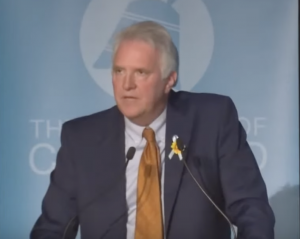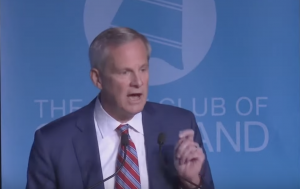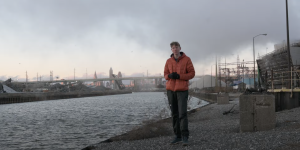From The City Club of Cleveland 9.20.22



Watch The City Club of Cleveland debate between the two candidates for Cuyahoga County Executive: Chris Ronayne and Lee Weingart.
www.teachingcleveland.org



A bumpy road to regionalism
by Jay Miller, Crain’s Cleveland Business 9/19/22


Will Cleveland Ever Develop Its Lakefront?
New Plans Are a Step Closer The pieces coming together for a bold, new vision for the lakefront.
by Ken Prendergast – Cleveland Magazine August 2022
The link is here


CLEVELAND, Ohio — They were big, bold, and visionary. And they never made it from blueprint to reality.
Since the late 1980s, planners, developers, and civic organizations have come up with at least nine big plans for developing the downtown lakefront, including proposals about how to better connect downtown to Lake Erie. Yet downtown is still firmly separated from the water by the Ohio 2 Shoreway and rail lines used by Norfolk-Southern and the Greater Cleveland Regional Transit Authority.
Here’s a list of the lakefront proposals, and what happened to them:
– The city’s 1988 Civic Vision 2000 Downtown Plan included Progressive Corp.’s proposal to build a lakefront skyscraper headquarters designed by architect Frank Gehry that would have risen next to an extension of the downtown Mall overlooking North Coast Harbor. Progressive dropped the idea and built its headquarters in suburban Mayfield.
(Related coverage: Could downtown Cleveland’s parks and public spaces be more fun and better programmed? A new survey seeks answers)

– A new downtown plan called “Civic Vision 2000 and Beyond’’ grew out of a closed-door process in 1997-98 led by executives of Cleveland Tomorrow, representing the city’s top corporate leaders. The plan included a concept for linking downtown more strongly to the lakefront. After a big rollout, it never gained momentum.

– In 2001, Cleveland Tomorrow and the Growth Association, then the city’s chamber of commerce, followed up with a concept called “The Shoreway: Reclaiming Our Lakefront’’ that aimed at revamping the lakefront highway to foster development between downtown and the lakefront. The proposal was the first to take a serious look at the issue.
– In 2004, the city completed its Waterfront District Plan, the biggest lakefront vision in 50 years. It was led by then-city planning director Chris Ronayne, working under former mayor Jane Campbell. (Ronayne is now the Democratic candidate for Cuyahoga County executive.) The plan called for extending the Mall over the Shoreway in a manner that anticipated a proposal like the 2021 Haslam proposal.

– A 2009 plan developed under then-mayor Frank Jackson, led by waterfront planner Stanton Eckstut, called for extensive redevelopment of lakefront land owned by the city and the Port of Cleveland, with new blocks oriented diagonally to deflect prevailing winds. A 2012 update included a spot for a pedestrian bridge from the Mall to North Coast Harbor.

– The 2010 Cleveland Design Competition, conceived by local architects, challenged contestants to figure out how to use a multi-modal transportation hub as a connector between downtown and the lakefront. Entries by more than two-dozen teams came from around the world. The ideas were visionary but failed to motivate action.

– In 2013, expanding on ideas from the Eckstut proposal in 2009, Cleveland developer Dick Pace and Texas-based developer Trammell Crow proposed widening the East Ninth Street bridge over the Shoreway with a parklike expansion and building a Mall extension slightly to the east of the one later proposed by the Haslams. The city didn’t approve of the idea, Pace said.

– In 2014-2016, the non-profit Group Plan Commission proposed an eye-catching, $25 million pedestrian bridge designed by Boston architect Miguel Rosales, to connect the Mall to the Rock Hall. After the estimated construction cost rose, the city rejected the concept as impractical and too expensive.

– A 2019 concept developed by the nonprofit Green Ribbon Coalition proposed extending the Mall as a wide “land bridge’’ oriented northeast toward North Coast Harbor. The concept stirred public interest, but the city stayed mum on it until Jackson said in 2021 that he liked the Haslam proposal, which he described as a “land bridge.”




by Jacob T Mach, 2020, Master of Arts (MA), Bowling Green State University, History.
Ohio politics during the Reconstruction era has received sparse treatment by historians. Not until 1970 with Felice Bonadio’s North of Reconstruction was there a monograph solely dedicated to Ohio politics during the era. Robert Sawrey wrote his Dubious Victory in 1992, but still the historiography on Reconstruction Ohio remains dramatically underdeveloped. In Ohio, the question of African American suffrage was the single most divisive issue facing politicians during the era. Radical Republicans brought a referendum before the people of Ohio in 1867 to change the state constitution to protect the suffrage rights of both white and black males above the age of 21. The measure failed 216,987 votes (45.9 percent) to 255,340 (54.1 percent) votes. The failure of the suffrage amendment disheartened many Radical Republicans across Ohio and the rest of the North, yet Ohio Republicans managed to elicit more support for suffrage than most states in the North. Such support did not arise randomly; it intentionally developed over a three-year period beginning after the Civil War. Two primary research questions drive this project: 1) Did suffrage become a crucial issue in the state of Ohio earlier than the existing historiography suggests, 2) why were Ohio radicals able to generate more support for black suffrage within the Republican party than in other states in the North? By showing that Republican support (through Congressional voting records, public support via speeches and letters, and by Republican-sympathetic papers throughout the state) for black suffrage existed in significant numbers in 1865 (prior to 1866-1867, as Bonadio, Sawrey and others suggest) in both the Western Reserve and in other parts of the state and only continued to grow until the referendum in the fall of 1867, this project will argue that black suffrage was not only being pursued by radicals, but ultimately by the vast majority of the Republican party. Ohio’s inability to secure black suffrage with overwhelming Republican support will in turn help to explain why other northern states achieved even less success in their pursuit of black suffrage.